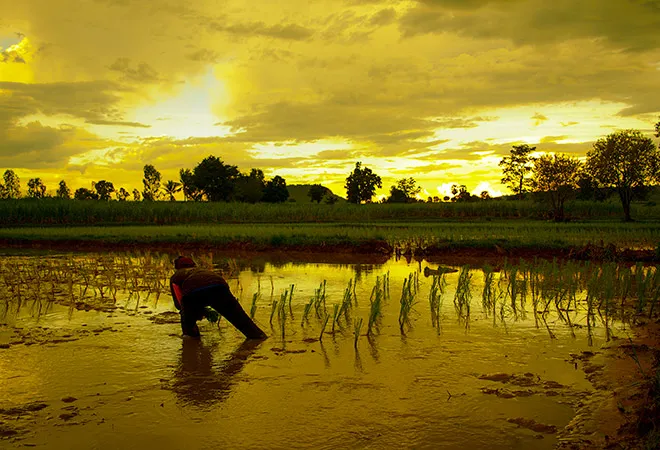
The extreme water shortage in major Indian cities, particularly Chennai, has brought public attention back to the issue of India’s water scarcity. Though experts, environmentalists, and NGOs had been crying out loud about India’s impending water crisis for a long time, they failed to garner public attention until the taps went dry in big cities. In fact, the government’s own think tank, the NITI Ayog, released a report in June last year: “Composite Water Management Index (CWMI) a National Tool for Water Measurement, Management & Improvement” in which it acknowledged that the country was suffering from the worst water crisis in history and about 600 million people or about 45% of the Indian population (which is roughly equal to the population of Latin America and the Caribbean) suffer from high to severe water stress. Further, the report predicted that 21 Indian cities will run out of ground water (which is the main source of water in most Indian cities) by 2020, nearly 40% of the population will have absolutely no access to drinking water by 2030, and 6% of India’s GDP would be lost by 2050 due to water crisis. Just one year after the release of this report, the government has announced an ambitious target of providing piped clean drinking water to all rural households by 2024. Although a worthy goal, it is unclear how the government proposes to achieve this formidable target under the current circumstances.
Any serious effort towards water management in the country should focus on the management of agricultural irrigation in India.
In order to address India’s water problems, it is important to understand that the roots of the current water crisis do not lie in a deficient or delayed monsoon as is being made out by the Indian media. In fact, it is years of government neglect, wrong incentives and outright misuse of the country’s water resources which has led to the current crisis. Moreover, it is important to understand that climate change would exacerbate India’s current water scarcity in the coming decades. According to a report by the World Bank, a global mean warming of 2°C above pre-industrial levels, the mismatch between water demand and supply will increase dramatically and will have serious implications on India’s food security. Although, the country has witnessed a dramatic increase in water demand for all uses: agricultural, industrial, and domestic, agricultural irrigation accounts for 90% of India’s freshwater withdrawals. Therefore, any serious effort towards water management in the country should focus on the management of agricultural irrigation in India. India’s annual agricultural water withdrawal is the highest in the world followed by China and the United States (Table 1). Further, the table shows that China, which has a larger area equipped for irrigation (69 million hectares) than India (67 million hectares), withdraws much less water for agricultural purposes. This is clearly inefficient and off course unsustainable.
Table 1: Countries with the largest agricultural water withdrawals
| Country |
Agricultural Water Withdrawals (billion m3) |
Total Water Withdrawals (billion m3) |
Share of Agricultural Water Withdrawal in Total Water Withdrawal (%) |
Area Equipped For Irrigation (m ha) |
| India |
688 |
761 |
90 |
67 |
| China |
358 |
554 |
65 |
69 |
| United States |
175 |
486 |
40 |
26 |
| Pakistan |
172 |
184 |
94 |
20 |
| Indonesia |
93 |
113 |
82 |
7 |
Source: World Bank (2018)
Over the years, India has witnessed a major shift in the sources of irrigation. The share of canal irrigation in net irrigated area has declined rapidly and groundwater irrigation now covers more than half of the total irrigated area. It is this overexploitation of groundwater resources, more so, in the north-western part of the country which is one of the main reasons for India’s water crisis. Moreover, groundwater is used to cultivate some of the most water intensive crops like paddy and sugar cane in states like Punjab, Uttar Pradesh, and Maharashtra. Rice, which is India’s main food crop consumes about 3,500 litres of water for a kilogram of grain produced.
State governments should encourage cultivation of less water intensive crops like pulses, millets and oilseeds in water stressed regions and water guzzler crops, particularly rice should be grown only in water rich areas.
The most important crops of India — rice, wheat and sugarcane, are the most water consuming crops. Rice which is a major export crop, consumes about 3,500 litres of water for a kilogram of grain produced. Punjab, which is the third largest producer of rice, is completely dependent on groundwater for the production of rice. Although, the state fares well in terms of land productivity, it is way behind the eastern states in terms of water productivity. Punjab requires two to three times as much water as Bihar and West Bengal to produce a kilogram of rice. State procurement policy and subsidised electricity makes it profitable for farmers to produce rice whereas farmers in states like Bihar, West Bengal, Assam, and Tripura which are better endowed in terms of rainfall lack these incentives. Unfortunately, India has emerged as a major exporter of rice which means a water scarce country like India is actually exporting millions of litres of water annually. Same is the story of sugar cane, another water guzzling crop in Maharashtra. Farmers in Maharashtra cultivate sugar cane using groundwater because they are assured of marketing by the sugar mills whereas Bihar which is more suitable for the production of sugarcane only produces 4% of the country’s total sugar cane output. Therefore, state governments should encourage cultivation of less water intensive crops like pulses, millets and oilseeds in water stressed regions and water guzzler crops, particularly rice should be grown only in water rich areas. In addition to the faulty cropping pattern, water use efficiency in agriculture is also very low. Flood irrigation is the most common form of irrigation in India which leads to a lot of water loss.
In order to avoid the doomsday when we actually run out of food and water, the country needs to introduce a slew of measures immediately. Firstly, as explained above, the northwestern and central part of the country which is severely water stressed should stop producing water-intensive crops like rice and sugar cane. Farmers should be given adequate incentives to switch to shift to crops like millets which require much less water and are climate resilient. Secondly, the spread of drip and sprinkler irrigation systems should be increased rapidly with state support. Thirdly, new agronomic practices like sub-surface irrigation, raised bead planting ridge-furrow method of sowing, and precision farming etc which have the potential to reduce water-use in agriculture should also be adopted. But is anyone listening?
Shreya Bhardwaj is a research intern at ORF.
https://niti.gov.in/content/composite-water-management-index-june-2018-0
The views expressed above belong to the author(s). ORF research and analyses now available on Telegram! Click here to access our curated content — blogs, longforms and interviews.




 PREV
PREV


